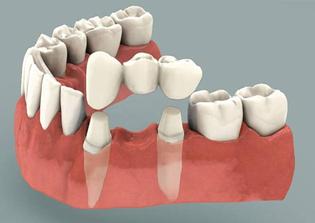Implants and Tooth Replacements

Filling the Gaps
When a tooth is lost, there are several options for replacement:
- Don’t replace it. The problem with this is a loss of chewing function, poor esthetics, possible speech issues, and eventual drift and tipping of the teeth, leading to a bad bite situation.
- Removable replacement. Years ago, it was quite common to replace missing teeth with a “removable partial denture” and they are still available today. They are an economical option, but they can be annoying to remove several times a day, they tend to loosen over time, and they can cause food traps against the supporting teeth, leading to more cavities.
- Cemented bridges. Most commonly used to replace one missing tooth (although certain designs can accommodate more), dental bridges or fixed partial dentures are ceramic or metal-and-ceramic restorations that rely on the teeth adjacent to the missing tooth space to support a false tooth. In most cases, it’s like a crown for the back tooth and a crown for the front tooth with a “pontic” tooth in the middle…all fused into one device. The benefit is a quick resolution to a problem, but the downside is if any part of the bridge develops a problem in the future, the entire bridge needs to be replaced. The preparation is also quite aggressive to the supporting teeth, particularly if they don’t already have crowns or large fillings.
- Dental Implants. These titanium posts act like the roots of actual teeth and support the crown part of the restoration. Dental implants can be single-tooth replacements or support multiple teeth. There is a healing phase to utilizing dental implants and they can be quite costly up front, but they are currently the optimal tooth replacement for a healthy individual regarding comfort, esthetics, and longevity of the restoration.
View some of the additional services we offer here!